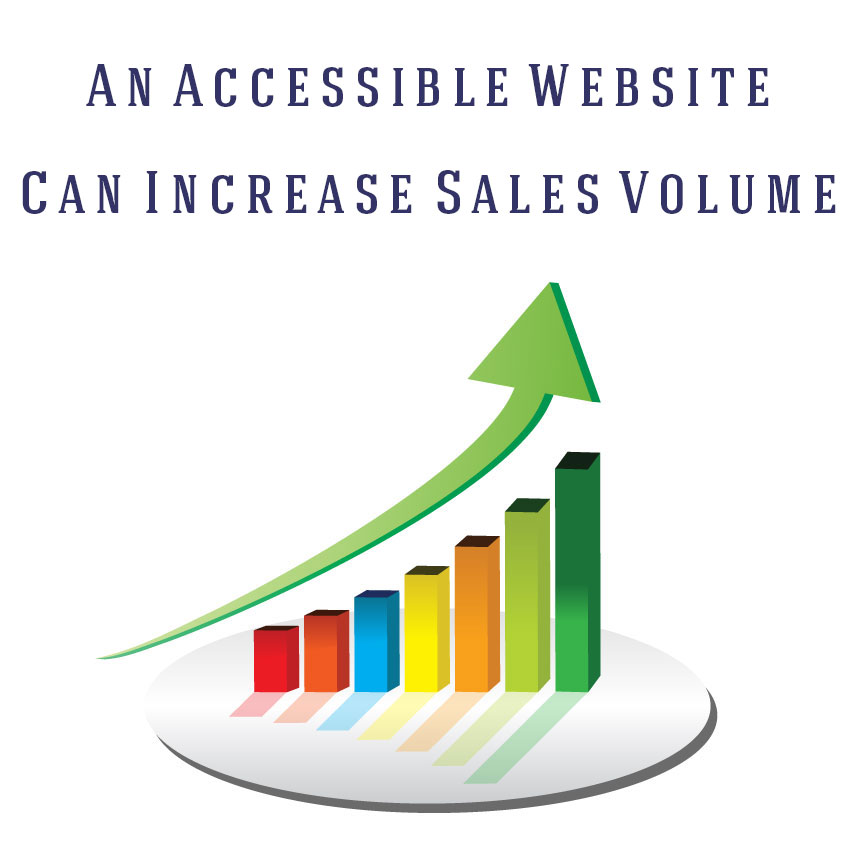The Business Case for Building an ADA Compliant Website
Having an Accessible Website is Good For Business
In my experience most businesses would rather have an accessible/ADA compliant website because it is the right thing to do and because they don’t want to get sued. Although businesses don’t deliberately intend to have inaccessible websites, it occurs more often than not because they either don’t know their website have to be ADA compliant or they lack the know-how to implement the many hundreds of standards required to achieve conformance.
What most businesses don’t realize is that accessible websites can provide them with additional market share and increase the reputation capital of their brand.

Having an accessibile website can result in a competitive advantage as more disabled users come online every day. They will favor the websites and businesses that are accessible to them.
In this article three pillars of ROI as they relate to accessibility will be discussed: acquiring an under recognized market share, risk management and aligning with the core values of your brand.
1. Acquiring an Under Recognized Market Share.
Accessibility increases your eCommerce and service based website traffic as the total population with disabilities is quite significant with a percentage of disposable income to match.
In a recent Nucleus Research report, researchers found that 2% of total eCommerce transactions are completed by people who are blind. This 2% is assuming that less than half of the blind population (which is 5 percent of the total population) are normal eCommerce shoppers and contribute that 2 percent share of total eCommerce. From these findings, we can infer that the total available market for consumers with visual impairments is about $10.3 billion.
The Nucleus Research report further states that more than 70% of websites visited by blind consumers who were surveyed had some type of critical accessibility issue which blocked their access.
This essentially means that they were either unable to view the website in whole or in part, or complete a purchase on a website.
If your eCommerce website is inaccessible, you could be losing out on a piece of the up to $6.9 billion annual market (70% of the $10.3 billion market share).
To put that in perspective, Homedepot.com reported an annual revenue of $6.94 billion in 2018.
Consumers with disabilities who are unable to access your website or complete a transaction on it will buy from somewhere else. You would forego large sales opportunities and also give your competitors buiness that you could have had by default.
A Significant Market
It is important to realize that working-age adults who have a disability have a market share of about $490 billion.
That’s 1 in 5 people between the ages of 16-65.
Comparatively, the African-American market segment is $501 billion, and the Hispanic market segment is $582 billion.
- The total disposable income for U.S. adults with disabilities is about $490 billion, which is comparable to other significant market segments, such as African Americans ($501 billion) and Hispanics ($582 billion). (Disposable income is what is left after taxes are paid.); and
- Discretionary income for working-age people with disabilities is about $21 billion, which is greater than that of the African American ($3 billion) and Hispanic ($16 billion) market segments, combined. (Discretionary income is the money remaining after deducting taxes, other mandatory charges, and spending on necessities, such as food and housing.)
2. Risk Management – Reducing your Legal Exposure
ADA-based cases so far in 2021 plot a path to 4,000 lawsuits in 2021.
Why the massive increase? Two elements might be in play. First, that due to COVID-19 websites have become more critical for everyone including customers, prospective customers, companies, the aging population and students. These are legitimate users who just want to use a company’s product, service or access information on a company’s website.
Second, predatory litigation has increased as well. More businesses are seeing lawsuits and demand letters from plaintiff attorneys who are just out for a quick settlement.
Another trend is that website accessibility/ADA compliance lawsuits are targeting the retail, hospitality, travel, food service/restaurant, financial and self-service industries.
If you receive a website (or app) accessibility demand letter under the Americans with Disabilities Act (ADA) $25,000 is a conservative final tab after you’re done paying for the plaintiff’s attorney.
Here’s the itemized bill for smallish businesses:
- $5,000-$15,000 plaintiff’s law firm fees
- $5,000 your defense attorney fees
- $5,000-$20,000 website / app audit and remediation
See, article by Kris Rivenburgh
Even just one website accessibility demand letter or lawsuit can be a huge hit to a small business
3. Aligning with the Core Values of Your Brand
A Forbes study. shows that modern consumers tend to take in a business’ core values when making purchase decisions. Seven out of ten U.S. Millennials actively consider the values of a company when selecting a business to do business with – compared with 52% of all US online adults. But it’s not just Millenials who are making value-based consumer decisions. A majority of Gen X consumers explicitly evaluate company values during a purchase, with four in ten young boomers following behind.
Most company core values include words like inclusivity, ease of use, always there, etc. If your company’s mission is to be inclusive, connected, customer-driven, simple, helpful, and custome centric, how can it not be accessibile to personw with disabilities?
A full 9 out of 10 blind Internet users are vocal anti-advocates for inaccessible companies, meaning their friends and family members are also making value-based buying decisions and choosing your competitors if your company’s website or application is inaccessible.
Additional Information
-
As of April 2021, there are 4.66 billion global web users according to Statista. Many of these individuals are part of the disability community, which encompasses a quarter of the U.S. population.HOW MANY PEOPLE NEED MY WEBSITE TO BE USABLE AND ACCESSIBLE? UsableNet
-
“ADA-based cases so far in 2021 plot a path to 4,000 lawsuits in 2021.”Midyear 2021 ADA digital accessibility lawsuit report UsableNet
-
“If you receive a website (or app) accessibility demand letter under the Americans with Disabilities Act (ADA) $25,000 is a conservative final tab after you’re done at the buffet of plaintiff’s law firm.” Can You Afford $25,000? Website Accessibility Lawsuits Cost Money Kris Rivenburgh, Attorney-at-Law | Founder of Accessible.org | July 21, 2020



